If you're looking for an easy and simple way to preserve onions, you have to try dehydrating onions! This method can be made in a dehydrator, or in a low-temperature oven. You can even turn some of the dried onion pieces into a flavorful homemade onion powder.
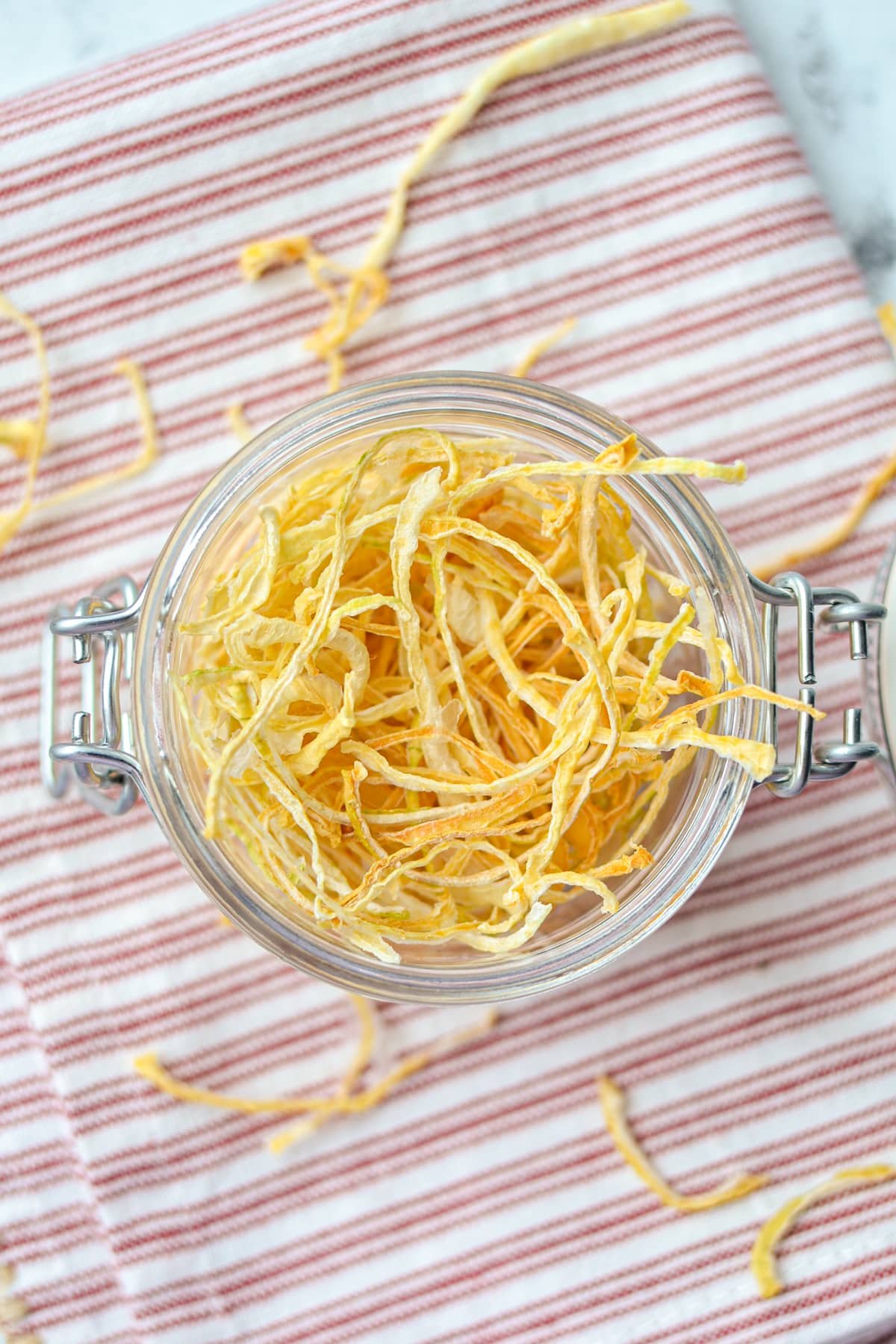
One of the easiest methods of food preservation is dehydrating. While canning and fermenting are an important part of our food storage strategy, dehydrating foods is such a great way to quickly preserve a bumper crop or excess.
This complete guide for dehydrating onions shows you how to dry your own onions at home, and you'll soon see how easy the process can be. Even if you don't yet have a dehydrator, you can make your own homemade dried foods easily using a low temperature oven.
Best of all? They store at room temperature for months (or even longer), and can easily be added to your favorite recipes. You can even make your own homemade onion powder with some of the dried onion pieces. I promise you it tastes WAY better than anything you've ever had from a store.
Why Dehydrate Onions?
- It's the best method for preserving a bumper crop or farmer's market haul - no cold room or canning jars needed!
- A great way to preserve short storing onions like Vidalia and red onions.
- Dehydrated onions are the first step to making your own homemade onion powder, which tastes WAY better than anything you can get at a store.
- Store-bought dried onions lack the flavor of this homemade version. Homemade is better, fresher, and cheaper too!
Ingredients and Equipment
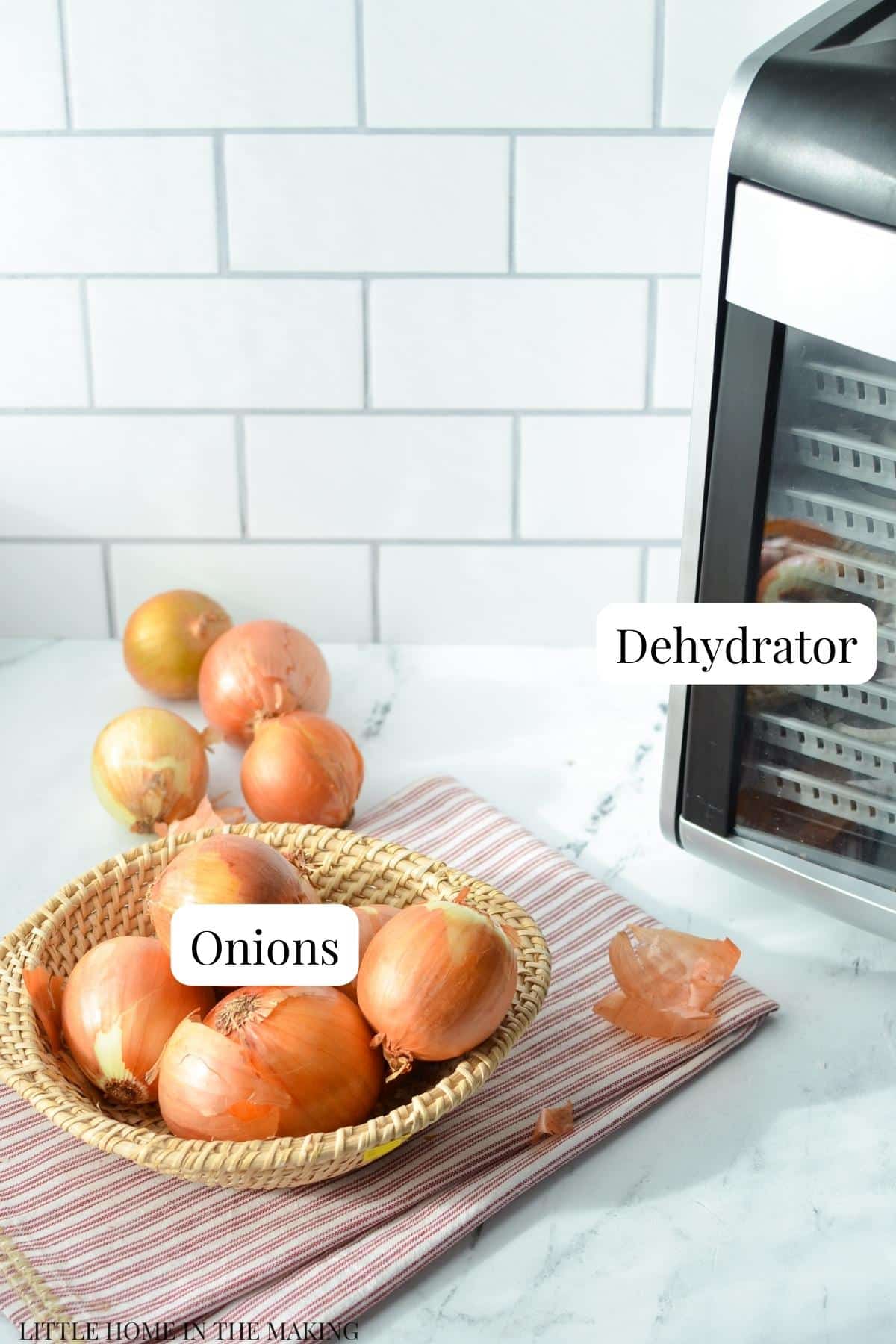
- Onions: This recipe works for regular yellow cooking onions, red onions, and even sweeter onions like Vidalia. If you have shallots, I recommend following my dehydrated shallots recipe instead - they require a bit less time.
Equipment
- Dehydrator (or Oven): A dehydrator works best (I'm ordering the Excalibur), but you can use your oven set to the lowest temperature (check your manual) and rotate baking sheets if you're in a pinch.
- Sharp knife: In order to get super thin onion slices, I highly recommend working with a sharp knife.
- Parchment paper (or mesh trays): If your dehydrator has large holes, you can make sheets of parchment paper to keep the smaller shallot pieces in place. OR you can use mesh trays or fruit leather trays if they are available for your model.
- Glass jar: This is used for conditioning, but can also be used for long term storage.
- Lid: You will also need lid that fits your glass jar - a mason jar with a two piece or plastic lid works great.
- Spice grinder (for onion powder): If you want to make homemade onion powder with some of your dried onions, you'll also need a clean spice or coffee grinder. I have this one and I use it for making all of my homemade vegetable powders and seasoning blends.
How to Dehydrate Onions
Dehydrating onions is a pretty straight forward way of preserving onions, and it can be a pretty hands-off process when using a dehydrator. If you don't have a dehydrator, no worries - just follow the oven instructions included further down (or in the recipe card).
Preparing the Onions
Before we get started on the actual dehydrating process, we need to prepare the onions. This can be done a few different ways.
I tested out chopping the onions as well as slicing them. When it comes to sliced onions, those that are separated into individual pieces before dehydrating dried the best. Diced (or minced) onions yielded a similar result to that of store-bought dried minced onions.
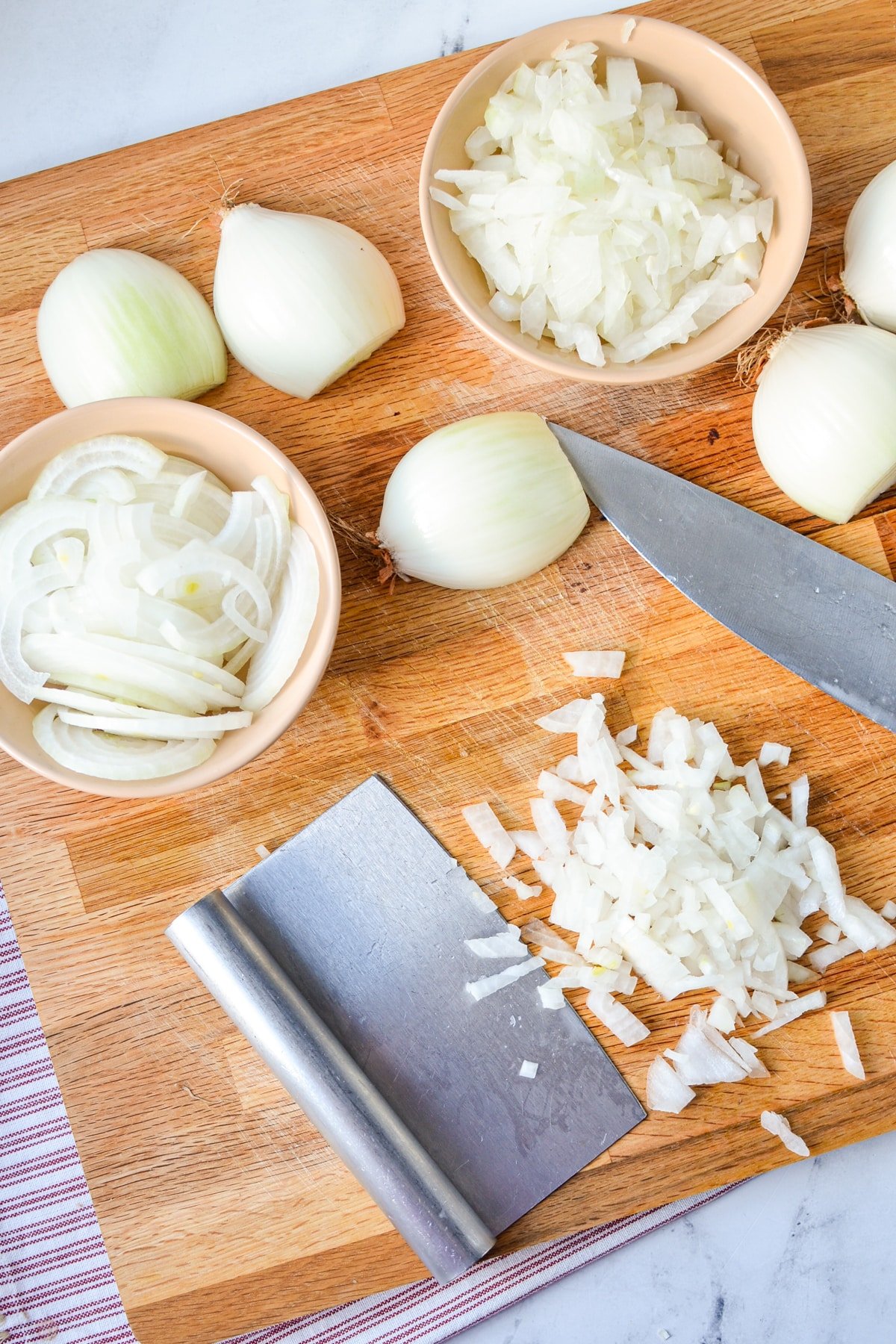
Use a sharp knife to either slice your onions very thin, or chop/mince them for a flaked onion result.
Dehydrating Onions Using a Dehydrator
If your dehydrator trays have large holes, line them with parchment paper OR with silicone dehydrator liners.
Add the sliced (and separated) onions or minced onions in a single, even layer. Aim to space the onion pieces far enough apart that they don't touch - this helps them dry more evenly.
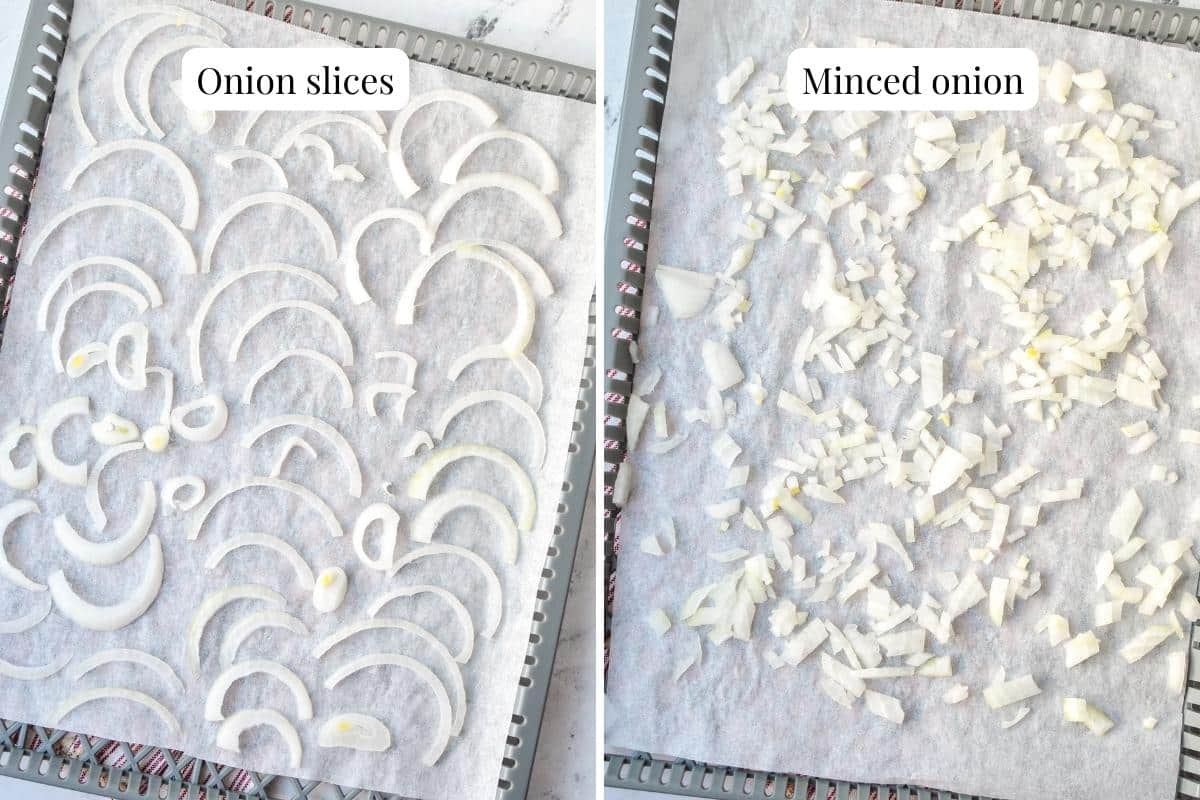
Add the filled dehydrator trays into the dehydrator, spacing them out evenly if you are not dehydrating enough onions to fill all of the trays.

Set the dehydrator temperature to 125ºF (52ºC) and close the door tightly. Dry the onions for 10-24 hours, or until the pieces are brittle and easily break. Onion flakes should be hard and firm, and your fingernail should not be able to pierce them.
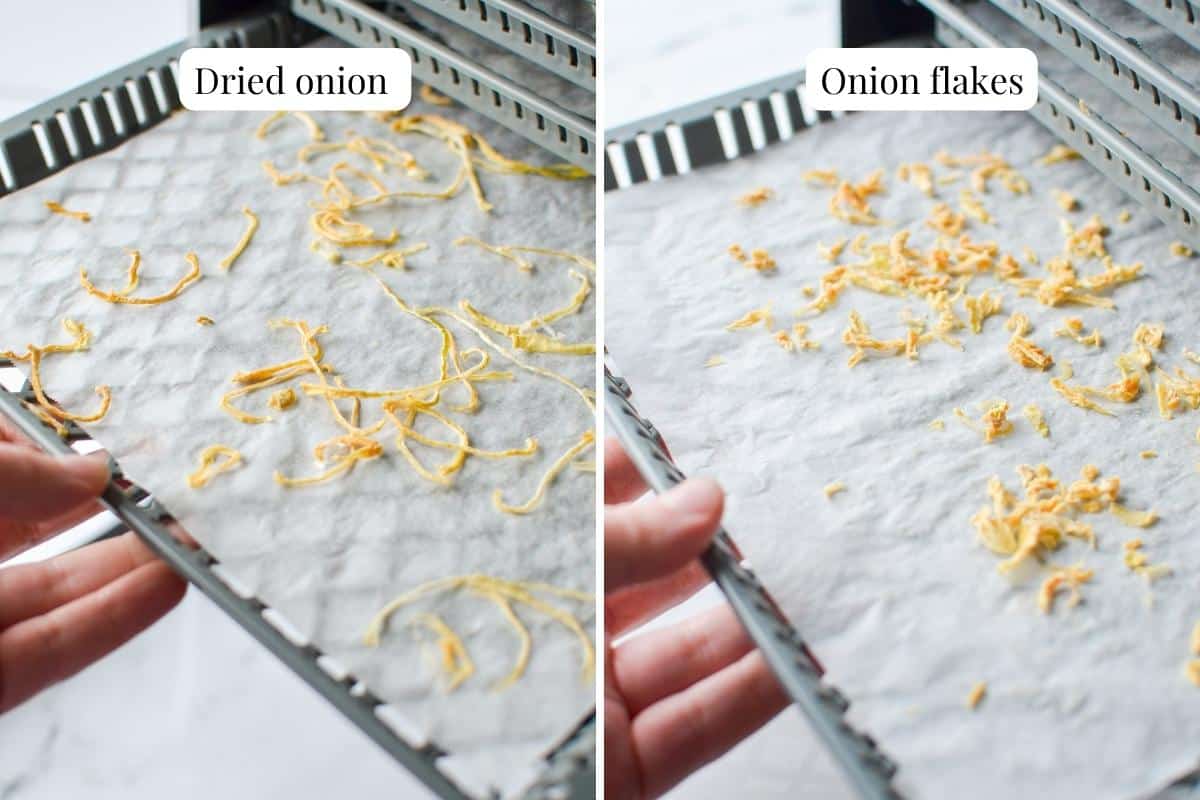
Once your onions are completely dry turn off and unplug the dehydrator. You can allow the onions to cool to room temperature inside of the dehydrator, or remove the trays to the counter to cool for an hour or so.
Once your onions are cooled, you're ready to move forward to the next step: conditioning.
Dehydrating Onion Flakes
Making your own dried onion flakes is as easy as choosing to chop your onions before you dehydrate them. The pieces should be about ½" or less in size once chopped.
After about 10-24 hours of drying at 125ºF they should reduce greatly in size and be very similar to dried onion flakes.
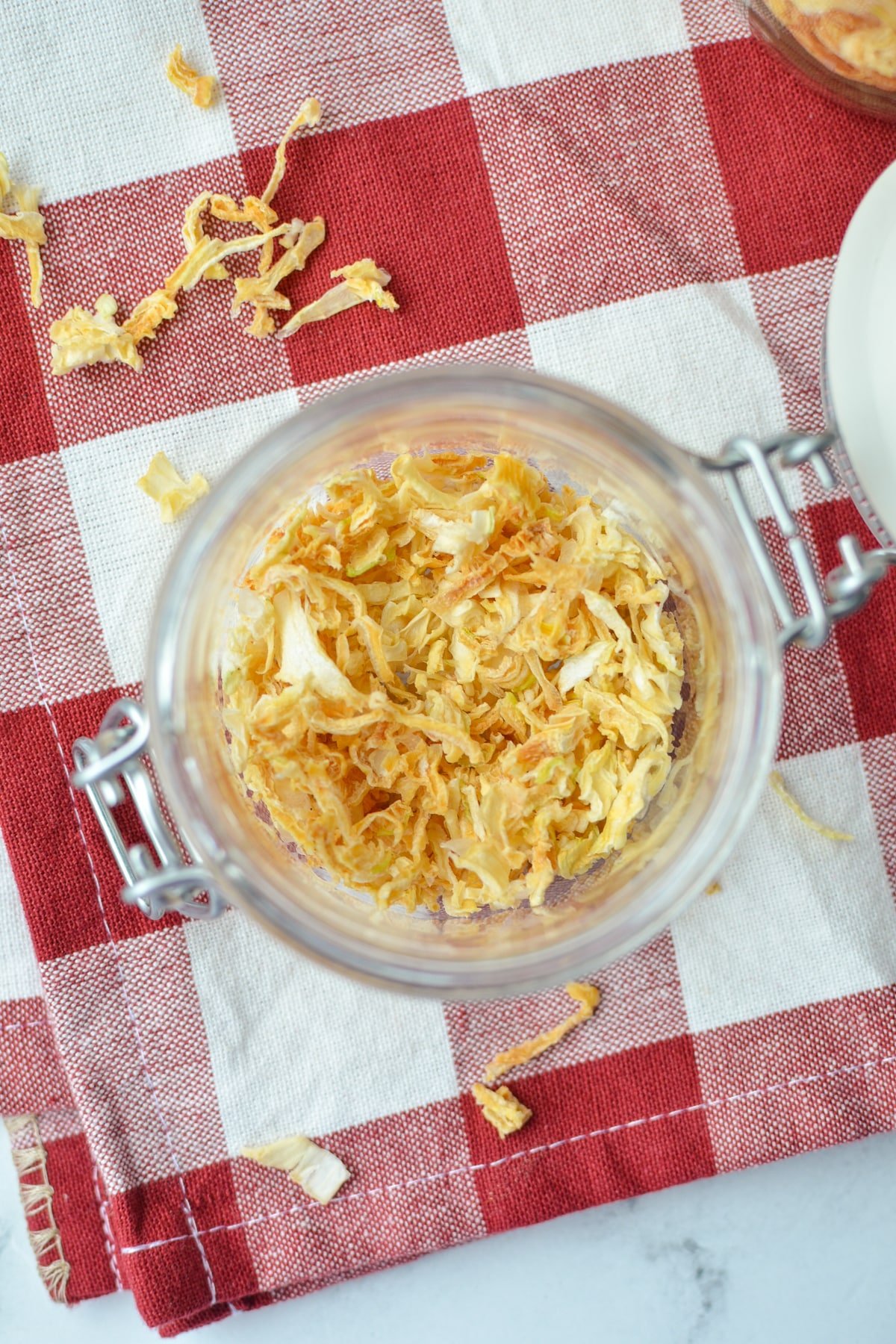
Store your dehydrated onion flakes in an airtight container for 4-12 months after checking for moisture. For longer storage add them to mylar bags with oxygen absorbers, seal, and store for 12 months or longer.
Dehydrating Red Onions
Red onions dry very similar to yellow onions, although they do sometimes hold a little bit more moisture. Just be sure to check them for brittleness before removing them from the dehydrator.
- Slice or chop peeled red onions.
- Spread the onions in a single, sparse layer on dehydrator trays lined with parchment paper.
- Set the dehydrator to 125ºF (52ºC).
- Dehydrate for 10-24 hours, or until the pieces are brittle and break very easily.
- Allow the onions to cool completely before transferring to a glass jar to check for moisture.
- Place a lid on the jar and place on the counter outside of direct sunlight.
- If after 24 hours the jar shows no signs of moisture (condensation or fogging), transfer the onions to an airtight storage container.
- Store for 4-12 months, or longer if you transfer to mylar bags with oxygen absorbers.
Dehydrating Onions in an Oven
If you don't have a dehydrator you can choose to dehydrate onions in an oven instead. You will need to set your oven to the lowest possible temperature (140-150ºF or 60-65ºC). You may need to check the owner's manual for your oven to see how to manually change the temperature.
- Set your oven on the lowest temperature (about 140-150ºF/60-65ºC).
- Spread the sliced or chopped onions onto parchment-lined baking sheets in a single layer, spacing the pieces evenly.
- Dry for 6-12 hours, rotating the sheets several times to ensure even drying.
- Once the pieces are brittle and break easily, remove them from the oven and allow them to cool to room temperature.
- Transfer the cooled onion pieces to a jar for conditioning.
- After 24 hours, if no condensation or fogging has occurred, transfer to storage or grind into onion powder.
Conditioning Dried Onions
An additional step that I recommend with all of my dehydrated food recipes is conditioning. This is a very easy process that acts as an insurance policy. Completing this step ensures there is no excess moisture, meaning you can return the food to dry further if needed. It's better to catch it early on, rather than once the moisture has already caused spoilage.
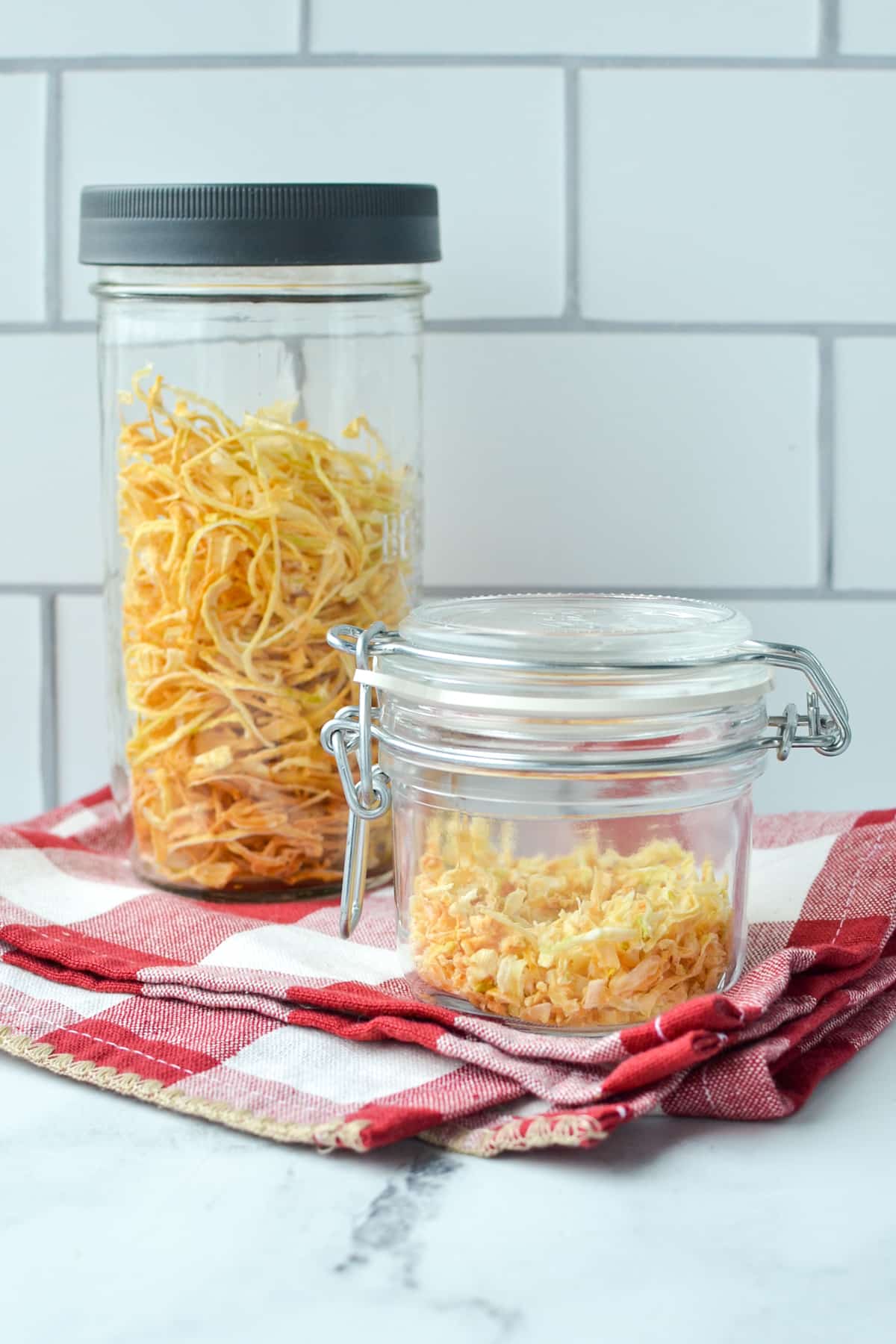
- Allow your dried onions to cool completely, then add them to a glass jar fitted with a lid.
- Place the jar in a visible location on your counter, outside of direct sunlight (which can cause condensation).
- Leave the jar on the counter for 24 hours, shaking it several times throughout the waiting period.
- If at the end of 24 hours there is no condensation or fogging, your food is dry enough to move to storage.
- Transfer your dried onions to an airtight storage container, mylar bags, OR grind into onion powder.
- Store for 4-12 months (longer if in mylar bags), discarding if there are any signs of spoilage.
Storage Tips
- Allow your onions to cool completely to room temperature before transferring to storage. Even slightly warm onions can cause condensation (and therefore moisture) in the storage container.
- For the longest storage, make sure to complete the additional step of conditioning the dehydrated food first. This ensures there is no hidden moisture, and redistributes any small amount throughout the pieces.
- For long term storage, consider using mylar bags with oxygen absorbers, vacuum sealing, or sealing into mason jars using a jar attachment.
- If you choose to make homemade onion powder with the dried onions, you may need to dry the powder a second time to get a finer texture. Onions hold a bit more moisture after drying, and even store-bought powders are clumpy. Doing a second drying helps reduce this slightly.
How long do dehydrated onions last?
Dehydrated onions wills store for about 4-12 months in an airtight container. For the longest storage, transfer them to mylar bags with oxygen absorbers, OR glass mason jars that have been vacuum sealed with a jar attachment.
If you choose to make homemade onion powder, your storage will be about 2-6 months, with clumping being normal and expected. For the best results I recommend leaving the dried onion pieces whole and grinding small batches into powder as needed.
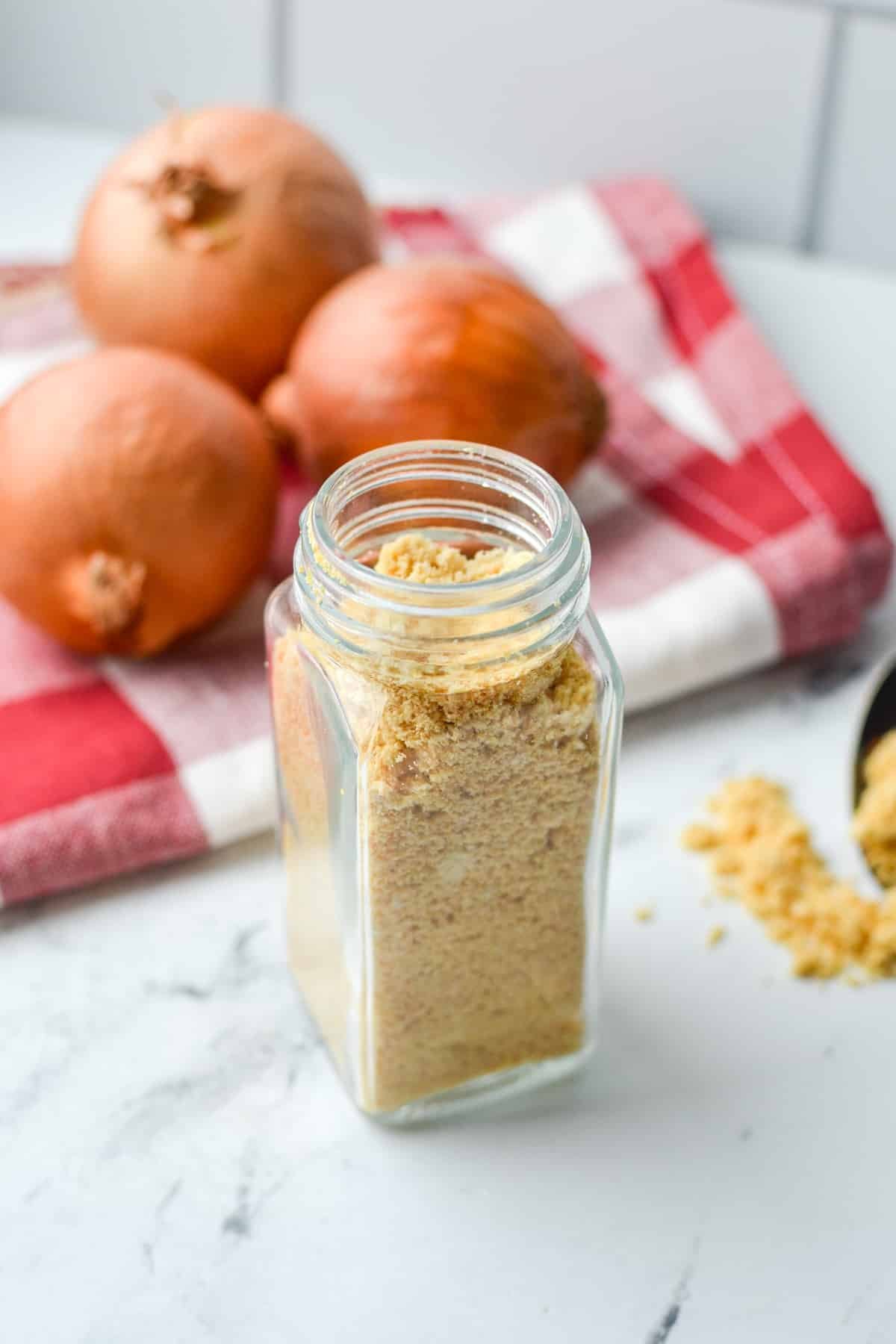
Making Dehydrated Onion Powder
Once your onions are completely dry and cool, you may be wondering if you can use them to make onion powder (similar to how you would make garlic powder). The answer is yes! I've written up a post showing you how to make onion powder, but here is the gist:
- Add your completely dry onions to a clean spice or coffee grinder, working in small batches.
- Place the lid on and pulse the onions, allowing them to begin to break down.
- Continue to pulse until they form a fine powder.
- If your onion powder is very clumpy or slightly moist, return it to the dehydrator and dry the powder for an additional 4-8 hours.
- Cool and grind again for a finer grind. Onion powder by nature is a bit more clumpy than homemade garlic powder or shallot powder.
- Transfer the powder to a spice jar or airtight container.
- Repeat with remaining onions until the desired amount of onion powder is made.
- Secure with a lid and store until needed.
Dehydrated Onions vs. Fresh
Dehydrated onions are simply fresh onions that have been dried until they are brittle and snap in half easily. Dried onions are half the size of fresh onions, and can be used almost anywhere you would use fresh onions.
Dehydrated onions can also be stored for a longer period of time, where fresh onions keep for just a few weeks on the counter, or up to 6 months in a root cellar.
Dried Onions to Fresh
Since dehydrated onions are about a quarter of the size of their fresh counterparts, I recommend starting by using ¼ of the amount of dried to fresh. So if your recipe calls for ¼ cup of minced onion, try 1 tablespoon of dried minced onion.
Using Onion Powder
Onion powder is much more concentrated than either fresh or dried onion, so if you would like to use it in a recipe you will have to use far less powder to fresh. I recommend starting with 1 tablespoon of onion powder for every 1 cup of fresh chopped onion called for in your recipe, and then tasting and adjusting for your preferred flavor.
How to Use Dehydrated Onions in a Recipe
If you would like to use your dried onions in a recipe, it's actually pretty easy to do! They work best in recipes where there is some moisture so they can become rehydrated and plump.
- Good uses include soups, stews, casseroles, or pasta dishes.
- If you want to use them without adding them to a liquid-heavy recipe, try giving them a quick soak in some warm water to rehydrate them. Drain and use as desired.
- Keep in mind that you can use dried onions and onion powder anywhere you may use fresh onions. I think onion powder works especially well for seasoning meats or adding onion flavor when you have picky eaters.
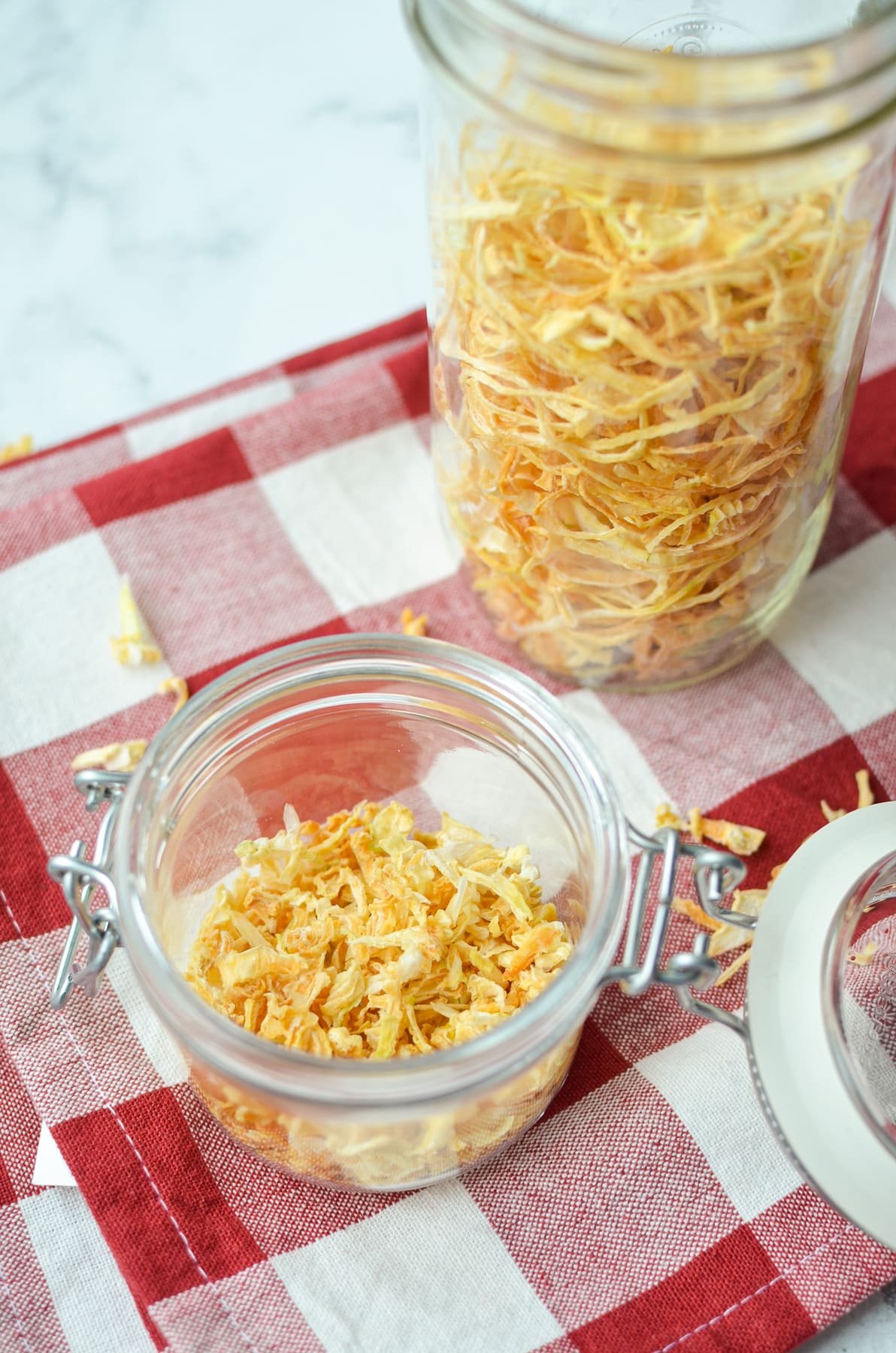
Frequently Asked Questions
Yes, you can dehydrate onions. Place sliced or chopped onions in a dehydrator that has been set to 125ºF (52ºC) and dry for 10-24 hours, or until the pieces are brittle and break easily. Transfer to storage and store for 4-12 months.
Yes, raw onions can easily be dehydrated. No need to cook the onions first - just slice, mince, or chop, and spread directly onto the dehydrator trays.
Onions need to dehydrate for a longer period of time compared to many vegetables. When the dehydrator is set to 125ºF (52ºC) you can expect for your onions to be dried in 10-24 hours.
Dehydrated onions can be used in a variety of dishes, but they work well in any recipe that has a good amount of liquid and at least 5 minutes of simmering time. This gives the onions a chance to rehydrate and plump up. Alternatively, you can soak your onions in hot water for 5-10 minutes, then drain before adding them to your recipe.
More Dehydrator Recipes
- Dehydrated garlic
- How to make garlic powder
- Dehydrated shallots
- How to make onion powder
- How to dry basil
📖 Recipe
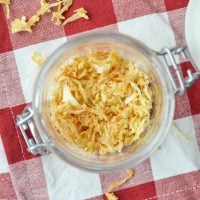
Dehydrating Onions
Ingredients
- Onions
Equipment
- Dehydrator or oven
Instructions
- Slice the onions in half and remove the peeling and film. Slice or dice your onion, depending on your preferences. Sliced onions work well for making onion powder, while chopped onions are great for adding to soups and stews and work the same as onion flakes.
- If your dehydrator does not have fine mesh screens, line the trays with parchment paper or silicone dehydrator liners.
- Place the sliced or chopped onion in a single, even layer on each of the dehydrator sheets. Ensure that there is ample room for the air to flow around each tray.
- Set the dehydrator to 125ºF (52ºC) and place each of the filled trays into the dehydrator.
- Dry for 10-24 hours, or until all of the pieces are brittle and break easily. Humid environments will take longer than dryer environments, so using the break test is the most reliable.
- Turn off the dehydrator and allow the sliced or minced onions to completely cool in the dehydrator, or remove the trays to the open air to cool for approximately 1 hour.
- Once the onions are completely cooled to room temperature, transfer them to a glass jar with a lid for conditioning - this checks for excess moisture.
- Place the glass jar in a visible location for 24 hours, shaking it a few times throughout. Do not place it in direct sunlight, as the heat can cause a greenhouse effect that will cause moisture to build in the jar.
- If any condensation or fogging shows in the jar, return your food to the dehydrator and dry again until it is brittle and passes the conditioning test.
- If your food passes the conditioning test, transfer it to airtight jars or containers (or mylar bags) for storage. Store for 4-12 months, discarding if there are any signs of spoilage.
- For onion powder: Add the completely dried onion slices (or flaked onion) to a spice or coffee grinder reserved for the purpose of grinding spices and powders. Grind until it is broken down into a fine powder. Then transfer to an airtight jar or container to store for 2-6 months.
Notes
Please note that some of my blog posts here at Little Home in the Making may contain affiliate links. If you make a purchase through these links, I will get a small commission at no additional cost to you. See our disclaimer for more information.



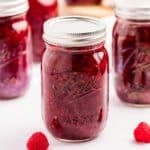





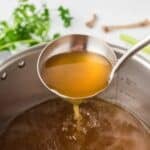



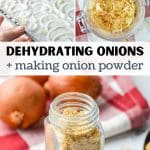


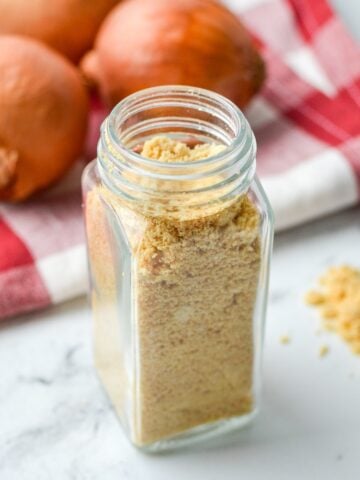
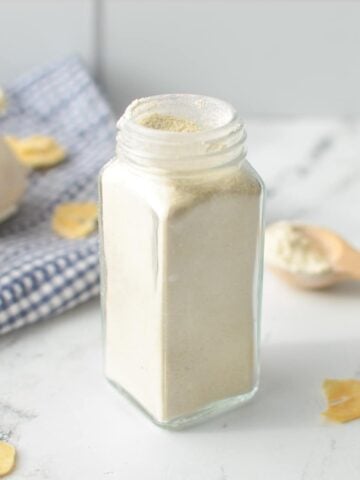
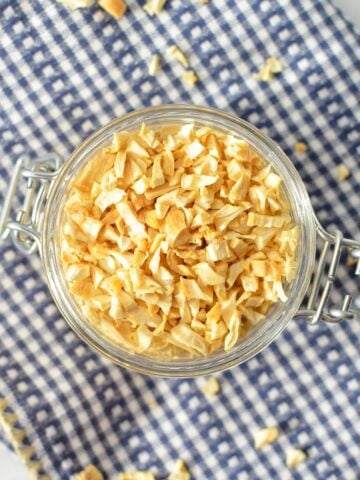

Leave a Reply